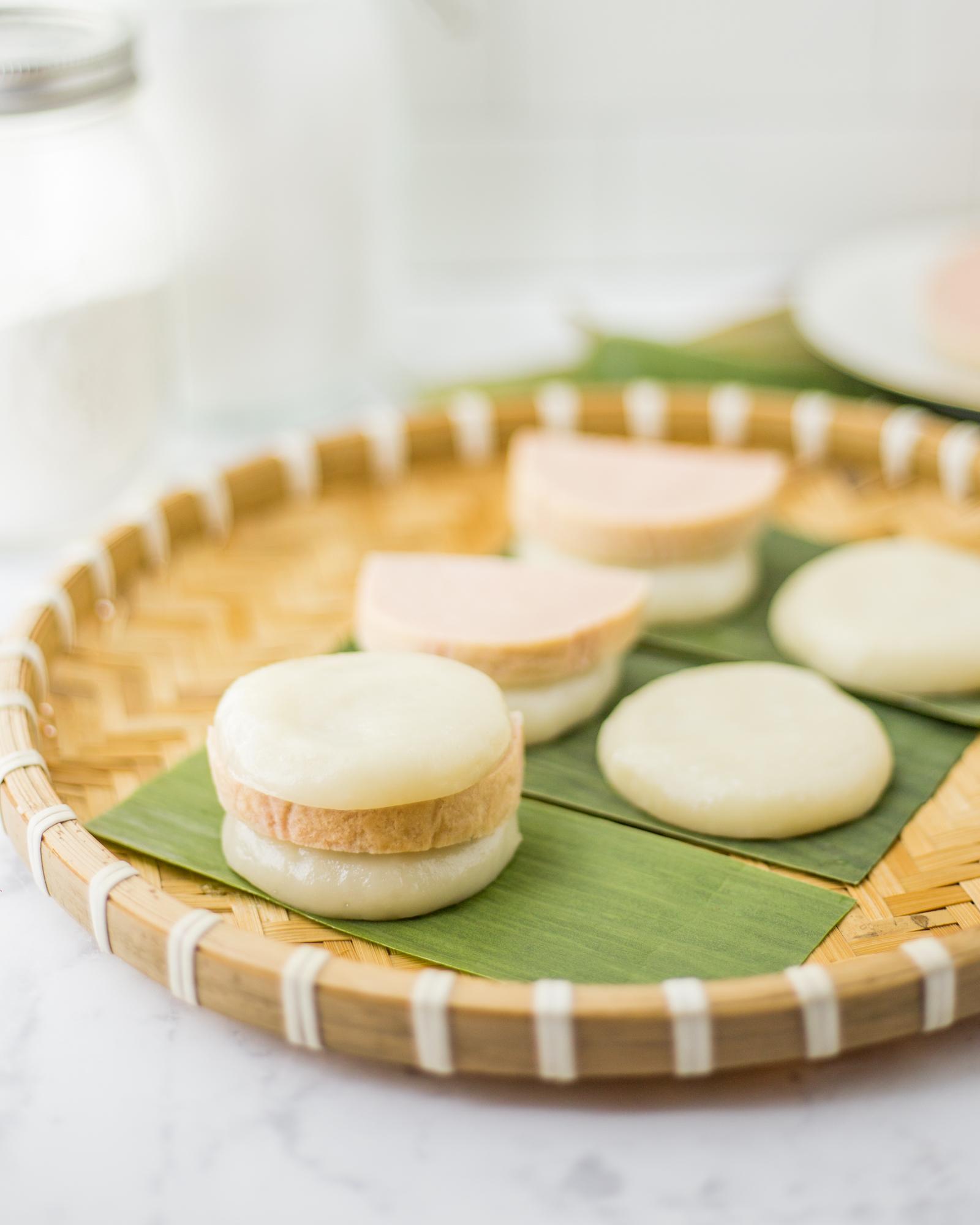Bánh giầy is one of my absolute favorite traditional Vietnamese snacks. You might also see it spelled as “bánh giày” or “bánh dày”. Steamed glutinous rice cakes commonly served with giò lụa (“chả lụa” in the Southern dialect – steamed pork sausage), chả quế (fried cinnamon pork sausage), or ruốc (“chà bông” in the South – pork floss).
- ITEMS TIỆN LỢI, THỜI TRANG PHẢI CÓ TRONG TỦ ĐỒ – GIÀY LƯỜI, GIÀY LƯỜI NAM DA BÒ FOR SHOES!
- 5 cách sửa giày bị tróc da màu trắng hiệu quả tại nhà trong 3 phút
- 7 CÁCH LÀM RỘNG GIÀY ĐƠN GIẢN HIỆU QUẢ
- 6 cách giữ màu tóc nhuộm cho nam siêu bền mà bạn nên biết
- Màu be (beige) là màu gì? Cách phối đồ, phối màu be đẹp thời trang
Even though it lack the complexity and flashiness of many other street foods, there is something about its simplicity that just does it for me. Made from glutinous rice, it is soft and chewy – the texture is similar to but thicker than that of Japanese mochi. There is also a sweet version filled with sweetened mung bean paste.
Bạn đang xem: MM Bon Appétit
Xem thêm : Top 700+ hình xăm bả vai đầy tính nghệ thuật và thẩm mỹ
Traditionally, these cakes are made from cooked and pounded high-quality glutinous rice. Many vendors in Vietnam still make them this way and it is the absolute best method. Bánh giầy made this way is incredibly fragrant and has the perfect texture. If you get a chance to try traditionally-made bánh giầy, you simply must!
However, just like traditional hand-pounded mochi, it is a lot of work and does not end up being an easy snack. That’s where glutinous rice flour comes in to save the day. Bánh giầy made with glutinous rice flour only takes 30 minutes and still tastes delicious.
Xem thêm : Bí kíp phối đồ với giày Converse cổ thấp giúp bạn chiếm spotlight
When buying from vendors in Vietnam, the version of bánh giầy served with giò lụa are normally sold in pairs: a thick piece of the sausage in between two rice cakes. Some people like eating them in sandwich-form like this. The way I grew up eating bánh giầy was how my mom prepared them for me: by stretching one between your hands, sprinkling it with a dash of salt and pepper, then wrapping it around half a piece of giò lụa like a cocoon. I think the ratio of bánh giầy to sausage is perfect this way! Check out our YouTube video to see what this looks like!
While is normally served with pork sausage or pork floss, the rice cakes themselves are fully vegan. You may be able to find “giò/chả lụa chay” – the vegan version of the steamed pork roll at Asian/Vietnamese grocery stores. If not, try serving them with a well seasoned piece of seitan or tofu!
INGREDIENTS FOR BÁNH GIẦY
- Glutinous rice flour – Bột gạo nếp: Flour made from glutinous rice. It is less commonly used than regular rice flour because like fresh glutinous rice, it has a very distinct sticky/chewy texture. For other recipes with glutinous rice flour, click HERE.
- Rice flour – Bột gạo tẻ: Regular/non-glutinous rice flour. The main ingredient in hundreds of other “rice cakes” that we have in Vietnamese cuisine. It is naturally gluten free. For other recipes with rice flour, click HERE.
- Salt – Muối
- Water – Nước
- Banana leaf – Lá chuối
- Vegetable oil – Dầu thực vật
- Giò lụa, chả chiên, chả quế, ruốc/chà bông (pork floss): You can buy pre-made giò lụa/chả lụa, chả chiên or chả quế from most Asian/Vietnamese grocery stores in the frozen section. Make sure the package does not say “giò bì” (unless you want the version with pork rinds).While is normally served with pork sausage or pork floss, the rice cakes themselves are fully vegan. You may be able to find “giò/chả lụa chay” – the vegan version of the steamed pork roll at Asian/Vietnamese grocery stores. If not, serve with a well seasoned piece of seitan or fried tofu.
DIRECTIONS FOR BÁNH GIẦY
- Combine glutinous rice flour, non-glutinous rice flour, and salt in a large mixing bowl.
- Make a well in the middle of the mixture and gradually pour in the warm water with one hand, while mixing with the other hand until there is no loose dry flour remaining.NOTE: the water should be warm but not uncomfortably hot to touch.
- Knead the dough gently until it becomes a cohesive lump and is no longer sticking to your hand.
- Cover and let rest while you prepare the banana leaf.
- Rinse and wipe dry the banana leaf.
- Cut out 10 squares with sides measuring 8 cm.They do not have to be perfect. I recommend tearing the banana leaf along the veins into strips of approximately the right width, then using scissors to cut these strips into squares. These are for steaming the bánh giầy.
- (Optional for serving) Cut out 5 rectangles 8 cm in width and 20 cm in length. Set these aside until Step 21.
- Use your fingers or a brush to add a thin layer of vegetable oil on the banana leaf squares.
- Divide the dough into 10 equal portions. They should weigh about 42 grams each.You can also pinch off and weigh the portions one by one as you go.
- Roll each portion into a ball between your palms.
- Gently press the ball into a disc about 1.5 cm thick and place on a banana leaf square.
- Repeat with the rest of the dough.
- Add water to a pot and place a steamer or steaming tray on top.
- Bring the water to boil on high.
- Once water is at a rolling boil, carefully place the banana leaf squares & cakes into the steamer. Make sure to leave space between the squares to avoid the cakes touching and sticking as they will expand when steamed. This means you may have to steam the cakes in batches.
- Close the lid, reduce heat to medium high, and steam for 9 minutes.
- Turn off the heat without opening the lid and let sit for 2 minutes.
- Carefully take the cakes out of the steamer and let cool on the counter.
- Repeat the process for the remaining cakes if you’re working in batches.
- Slice the giò lụa into thick slices, then cut the slices in halves.I recommend about 1 cm but it’s really up to you!
- Once the rice cakes have cooled down to room temperature, remove them from the banana leave squares and place 2 on each of the banana leaf rectangles from Step 7.
- Add a piece of giò lụa/chả quế to each pair of bánh giầy.
- Serve like a sandwich or my personal favorite way:Take one rice cake and stretch it between your hands. Sprinkle with a dash of salt and pepper. Then wrap it around a piece of sausage like a cocoon.
RECIPE VIDEO
Nguồn: https://leplateau.edu.vn
Danh mục: Kinh Nghiệm
This post was last modified on Tháng mười một 20, 2024 4:44 sáng

